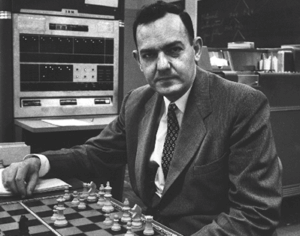What PR People Need to Know About [Art]ificial Intelligence
Published on October 2, 2017, at 3:20 p.m.
by Grace Turner.
It’s Amazon giving you product recommendations. It’s Facebook highlighting faces and suggesting friends to tag when you upload photos. It’s Gmail filtering spam from your email inbox. It’s artificial intelligence (AI), and it exists in the background of our everyday lives.

Logic Theorist, which is widely considered the first AI
program. (Photo by insideview on Flickr)
Despite all the hype (and terror) that surrounds it, AI as a field is nothing new. What is new is how far we’ve come: As the world digitizes, we have more data that needs processing, and only in the past few years do we have the capability to do it on such a large scale across various industries.
AI defined
AI is a broad umbrella term used to describe machines with the capability to make autonomous decisions.
A subfield of AI, machine learning is a set of techniques that researchers use to create programs that can make decisions. In other words, it’s a way to train computers so they gain some level of AI.
“Machine learning is popular today because we have so much data now, be it from social media, the internet or even digitized medical records,” said Jenna Losh, the president of the Machine Learning/Artificial Intelligence Club at The University of Alabama. “We can use machines to look for patterns in data that people wouldn’t necessarily be able to see.”
AI applied to PR
Public relations practitioners are often given the task of monitoring what consumers are saying about brands on social media, and machine learning makes it possible to monitor such feedback on a large scale.
Dr. Chris Vargo is a professor at Colorado University-Boulder who specializes in data analytics, and he actually teaches a machine learning course to advertising and PR students. He said machine learning is getting easier, cheaper and more accessible to use as social listening tools become more advanced and intuitive.
Vargo used the release of Chipotle’s new queso to explain how PR practitioners can employ machine learning techniques to gather consumer insights.
“There are millions of tweets about Chipotle’s queso right now; there’s no way that one individual public relations practitioner, or even a team of public relations practitioners, can actually look at all those tweets to know what some of the most common complaints are,” he said. “So instead we need to have some type of algorithm that can look through those tweets and tell us the most common things that people are saying about Chipotle’s queso.”
Vargo said this is an example of unsupervised machine learning because we don’t know what the right answers are; we want the computer to figure it out. On the other hand, supervised machine learning requires just that — supervising a computer and telling it the right answer.
Similar to receiving personalized playlists based off songs you ‘liked,’ Vargo said we can use platforms like Social Studio to monitor social media and tell the algorithm what posts we want to see more often. Let’s go back to the Chipotle example.
“If we only want to retweet positive Chipotle queso tweets, we could start to find some on Twitter and basically flag them as positive queso mentions,” he said. “Eventually the computer is going to learn what a positive queso mention looks like, and it’ll actually pull those for us; we don’t have to look for those positive tweets. This is an integrative way in which Social Studio is doing machine learning.”
What we can do today
The field of data science is facing a major labor shortage. At IBM Vision 2017, data scientist Dr. Kyle Weeks said 83 percent of managers in 2016 couldn’t find any data scientists to hire. Although PR practitioners are by no means expected to be mathematicians or computer scientists, we can take steps to wield a competitive edge in the ever-changing field of PR as the industry becomes more digitized.
Vargo recommended the following for PR practitioners interested in learning more about the world of data science:
• The No. 1 most important factor is to have a basic understanding of statistics. He has his advertising and public relations students learn how to do basic statistics and become proficient in Excel. This can be done via online courses such as Lynda Excel Statistics.
• He said knowing a computer language is more important than knowing a foreign language in 2017. Although not everyone needs to be a programming guru, he thinks everyone needs to know how to make little changes and tweak a computer algorithm when needed. For example, PR agencies won’t be able to rely on a select few individuals with programming skills in the next five or 10 years, as we continue to put more emphasis on the value of data analytics in PR.
• For those interested in learning more about machine learning specifically, he said the best way to learn is by doing. There are cloud-based machine learning platforms that are relatively easy to use. Some cost money (e.g., DataRobot), but many universities offer free access to their students. One that’s free is called LightSide, which can be downloaded and installed to a computer.
What we can expect to see tomorrow
In the future, AI won’t be a buzzword confined to a high-tech niche area. Tomorrow’s PR will incorporate AI techniques into all of its functions, and it won’t just be the edgy digital agencies.
“We’re going to see a lot of automation in everyday, repetitive tasks such as pulling media lists and counting impressions,” Vargo said.
“It won’t be hard to train a computer to automatically pull all the news stories that mention your brand or product and email it your boss,” he said. “That’s not worth your time and that’s not worth your client’s time, so those things are going to be automated. Some aspects of entry-level PR jobs will be automated, but not everything will. You’re still going to have to cold call or email people to get press releases out.”
Some agencies say that with these rudimentary tasks taken care of, creativity will be able to flourish.
However, machines have already been programmed to take over creative roles. In 2016 McCann Japan appointed an AI creative director, which uses historical data to make strategic decisions. Computers have even been trained to perfectly imitate classic artists like Rembrandt or Picasso.

But it’s not just imitation anymore. Research teams are working on projects that will potentially enable machines to generate art and music on their own. The Google Brain team’s Magenta project is one of many that push the bounds of machine creativity.
“It’s basically writing programs that can make human music,” Losh said. “And so it’s composing music using AI tools to develop melodies and play with sound. It brings about a ripe discussion because what is human music? This is a whole field that has never existed in human history, so it’s really cool.”
Researchers put many years of work into projects like Magenta and McCann’s AI system so that they may understand content and hopefully create artistic content on their own. There are so many different facets of life that computers can’t grasp, and Vargo doesn’t think computers will ever be creative the way humans can for this reason.
“Think about a tweet that goes viral,” he said. “A tweet that goes viral is clever that no one ever thought of before. Well, we can’t train a computer to think of things that people have never thought of before, unless it knows all there is to know about society, people and humor. Think about all the different evidence we’d have to give a computer to figure out how to come up with a clever tweet. We’re not there yet, and I don’t think we ever will be.”
The fact of the matter is computers aren’t good at coming up with new things, but humans are. And our creative whims can match the speed of our consumers’ attention spans.
Vargo said, “The really lovely and beautiful thing about humans in general is we get bored of things quickly, and we always like the new thing … we love unpredictability; we love things to be novel.”
While computers predict, humans are unpredictable. As the dynamic public relations field changes, that’s one thing that will never change.




